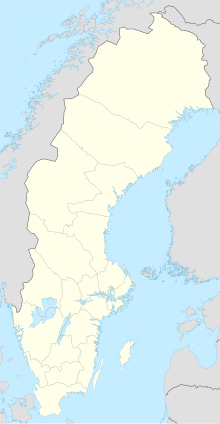Runestone from Salmunge
Coordinates: 59 ° 44 ′ 6.7 ″ N , 18 ° 26 ′ 59.2 ″ E
The Salmunge rune stone ( reg.no. U 519) comes from Uppland in Sweden . It is made of granite and was written in the “Younger Futhark ” at the end of the Viking Age in the 11th century .
inscription
“Jobjörn and Änne set up the stone in memory of Erbjörn, their father - Tule wrote these runes - may God see [him]”.
description
The rune stone aroused great interest as early as the 17th and 18th centuries. The scratch is flat, but clear and well preserved. The scribe mastered the technique and wrote evenly and confidently.
Elias Wessén
Elias Wessén (1889–1981), a Swedish runologist of the 20th century, saw a mixture of normal and difficult-to-interpret runic sequences. Wessén suspects that the scratcher followed a template that he could only partially interpret. When the stencil failed him, he filled in the gaps with runes of his choice. Wessén is also dissatisfied with the ornamentation of the rune stone and comes to the conclusion that the scorer was not an experienced master. Other runologists followed Wessén's criticism.
Henrik Williams
Henrik Williams (born 1958), runologist at Uppsala Universitet , has devoted a new analysis to the salmon rock and has re-translated the inscription. He comes to a different conclusion regarding the competence of the rune scratcher. The ornamentation and the orthography of the stone, which differs in some places, go back to a scratcher who did not choose the obvious, but also did not deviate too far from the usual. In contrast to Wessén, Williams recognizes that almost the entire inscription was to be interpreted due to an understanding of the expected content (for contemporary readers - which hardly existed), since the runic inscriptions of the end of the Viking Age almost all had a formula-like structure. The memorial formula reads: "A and B set up the stone in memory of C, their relative. D carved the runes." The final six runes form a Christian prayer formula, in this case with the previously unique wording "May God see [the deceased]". The reading direction, starting from the right and counterclockwise, is unusual, but the head of the serpent signals the beginning of the inscription.
literature
- Elias Wessén & Sven BF Jansson: Upplands runinskrifter 2. Sveriges Runinskrifter utgivna av Kungliga Vitterhets Historie och Antikvitets Academies, Stockholm. Volume 7 1943-46
- Henrik Williams: Rune-stone inscriptions and queer theory BPR Publishers 2008

